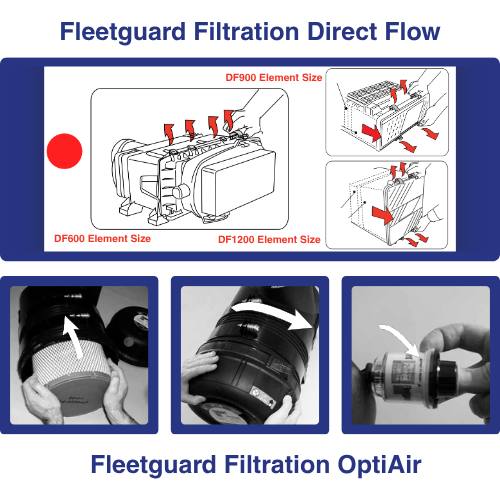
Air filters should be changed according to the engine manufacturer’s recommendation on airflow restriction as measured by an air filter restriction indicator gauge.
Yes, air filter element efficiency changes over time. Air filter elements are least efficient when they are new. The build-up of contaminant (dirt) on the medium will make it more efficient over time.
The ‘M’ stands for Magnum, designating it as a long life element.
Secondary or inner elements should be changed every third time the primary (main/outer) element is changed. The secondary (safety/inner) element should not be disturbed until this interval has been reached.
We recommend changing Fleetguard air filter elements when they have reached about 80% of the engine manufacturer’s maximum allowable restriction. As a general guide, this ranges from 375 to 625 mm (15 to 25″) of water gauge restriction (35-65 mbar or 3.5-6.5 KPa) for naturally aspirated engines and 500 to 700 mm (20 to 30″) or 50-70 mbar /5-7 KPa for turbocharged engines.
The performance of air filter elements is measured by testing their ability to remove particles across a broad spectrum of particle sizes using standard test dust and reporting the results as the percent efficiency for the given test dust.
The maximum clamp torque is 40 in-lb (4.5 N×m) on the outlet.
Conventional air filter elements are generally held in place inside the air cleaner housing by a wing nut on a threaded center post. This also seals the element to the housing by compressing a rubber seal (gasket), which is glued to the metal endplate of the filter against the base plate of the housing. In the case of Radial Sealing air filter elements, the sealing is complete by pushing the molded rubber (polyurethane) open end over a short tube built into the base of the air cleaner body. The filter is retained by the housing cover sitting against the closed upper endplate.
The major advantages of the Radial Sealing filters are the ease and speed of service. Generally, Radial Sealing air filter elements can be changed without needing to use tools. The air cleaner cover usually twists off or is removed by undoing “flip over” clips or catches, and the element is simply pulled off. Conventional housings often require wing nuts to be undone and, in some cases, a whole series of nuts have to be undone before the element can be removed.
No, the conventional air cleaner housings are not designed to create a complete seal with the Radial Sealing air filters.
No. Conventional primary/outer air filters have to be used with conventional secondary/inner elements and housings. Radial Sealing primary/outer air filters have to be used with Radial Sealing secondary/inner elements and housings.
A two-stage air cleaner has a pre-cleaner integral to the system. In most heavy-duty applications, the air cleaner will have a dust ejection valve. The majority of the heavy dust particles are removed from the air cleaner by this valve (stage 1). The remaining dust is then removed from the air by the primary filter element (stage 2).
Yes. The dust ejection valve must be pointed within 15° of straight down to have proper pre-cleaning abilities.